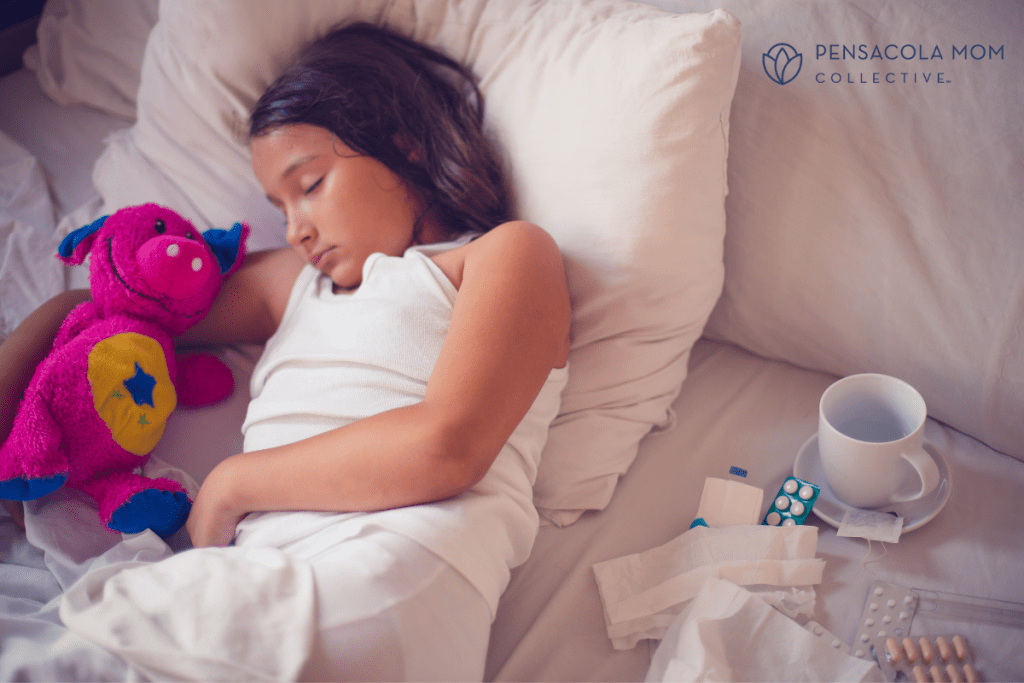 Tummy bugs – they are so contagious. You may feel nauseous just reading this post!
Tummy bugs – they are so contagious. You may feel nauseous just reading this post!
“My tummy hurts” are the three most dreaded words in our home.
As a registered nurse and mother to three little girls who have experienced multiple stomach bugs, I’m going to share with you the ins, outs, and must-have supplies for when the “you-know-what” hits the fan (literally!).
Once one of our children catches the stomach bug, I typically begin panic cleaning bathrooms, toilets, and puke buckets. Unfortunately, at that point, the infection has most likely already entered our bodies.
Stomach bugs are typically caused by norovirus or rotavirus and symptoms include vomiting, nausea, and/or diarrhea. The stomach flu, viral gastroenteritis, tummy bug, the “runs,” all usually mean one thing: you should be prepared with a bucket and a toilet nearby.
However, vomiting and diarrhea can sometimes be a child’s individual response to a different type of virus. Recently, our three daughters became ill . . . what started as a normal morning turned quickly with a 103.2° fever. Then, the dry heaving began. One of our daugthers was ill with stomach issues, and the other two with croupy coughs. My husband and I prepared for the whole house to fall apart while we cycled through the stomach bug. But after a visit to the pediatric emergency department at Studer Family Children’s Hospital at Ascension Sacred Heart Pensacola for severe dehydration, we realized Sloane’s symptoms were actually her body’s response to contracting RSV and parainfluenza 3.
She was unable to keep any clear fluids down for 26+ hours, and her urine output decreased by the hour. Once we made the decision to take her to the emergency department, she required IV hydration and a dose of Zofran, an anti-nausea medicine.
After the IV fluid infusion and medication administration, our daughter slowly became our sassy little girl again. Dehydration is the most serious complication when it comes to anything vomiting or diarrhea-related.
Be vigilant about keeping your child hydrated!
Stomach bug symptoms tend to trickle in about 24-48 hours after you have been exposed to the virus. They typically last two to three days, but can hang on for as long as 10-14 days! Along with vomiting, nausea, and diarrhea, other accompanying symptoms can include low-grade fever, overall body aches, and abdominal cramping.
Any type of virus is difficult to contain, especially in a family with multiple children.
As soon as the vomiting begins, it’s important to stop the intake of solid food. Keep track of symptoms, temperature, fluid intake, urine output, and amount of vomiting on a piece of paper (we use a whiteboard on the fridge). Hydration is key with the stomach bug because dehydration is a serious condition that can escalate quickly, especially in children.
Begin hydration SLOWLY with Pedialyte, or juice mixed with Pedialyte, if your child will not drink the Pedialyte alone. We use the unflavored Pedialyte in our home. Pedialyte popsicles are another favorite (and sometimes even substitute for regular popsicles when we run out).
You can hydrate your child with small amounts of Pedialyte every 15 minutes as tolerated:
- infants should take 1/2 teaspoon (2.5 ml)
- toddlers should take 1-1.5 teaspoons (5ml-7.5ml)
- school-age children should take 1-2 tablespoons (15ml to 30ml)
After two hours of no vomiting, you can gradually increase fluids.
After eight hours of no vomiting, you can offer your child small amounts of bland foods from the BRAT diet (bananas, rice, applesauce, and toast).
Remember, your child may be very thirsty and want more fluid but it is important to start with the smallest recommended amount to get vomiting under control before increasing fluid intake. If they are able to hold this down, you may slowly increase the amount and frequency. If they begin to vomit again, decrease the amount to the last amount and frequency fully tolerated.
With children, I recommend avoiding dairy until the virus has completely run its course. Milk and cheese are difficult to digest and could actually exacerbate diarrhea symptoms, especially in children.
As we all know, germs are spread easily. Stomach viruses are typically spread in infected saliva, stool, or vomit. Teaching your children to keep their hands and fingers away from their mouths (and yours) is imperative.
The viruses that cause stomach bugs are spread through ingestion, so keeping those hands and commonly touched surfaces disinfected is also key.
Once we are “in the clear,” we slowly begin reintroducing food via the BRAT diet. We also slowly start adding Activia probiotic smoothies into our daughters’ diet to provide some “good” bacteria for their gut to begin to heal.
According to this CDC infographic, a person sheds billions of virus particles in their stool and vomit. It takes only a small amount of these particles to infect someone else. For this reason, it is best to keep away from others while you are actively sick and for two days after. It is recommended to keep your child home from school and daycare for an extra two days after they are no longer vomiting or experiencing diarrhea to prevent the vicious cycle from continuing.
For us, it is easiest for us to have all of our children in the same room when they are ill. We line the playroom with blankets and towels, layering them over shower curtain liners, to prevent leaking. Extra sheets and towels are stacked nearby to replace those that are soiled. Wash soiled items in hot water and dry them on high heat.
Lastly, we cover their pillows with towels and pull their long hair back into a bun in the event they aren’t able to make it to the toilet or bucket.
Must-Have Items
XL puppy pads to line beds and surrounding areas to catch vomit and any other liquid
Pedialyte (we prefer the clear/flavor-free version to mix with juice)
Medium-sized trash can (one per child) with plastic bags to fit in to catch vomit
Waterproof vinyl mattress cover to protect leaking from vomit
Shower curtains to line floor/carpet around the bed to prevent staining on carpet
Large beach towels
Zofran if prescribed by a medical provider
As always, when in doubt, call your pediatrician! If something seems off or different with your child, do NOT delay medical care. Most times, parents know their children best. If for any reason your child isn’t urinating for more than 6-8 hours, is not making any tears when crying, has a dry mouth, sunken eyes, feels cool or clammy, or is confused, they should be evaluated by a medical provider right away.
Remember, you know your child best!
**Disclaimer- while I am a registered nurse, I am not a physician. These are my personal recommendations and I recommend you consult with a physician before taking or using any products, especially when it comes to your child. The statements in this post are not intended to diagnose, treat, cure or prevent any medical condition. Always consult your personal physician for specific medical advice.














